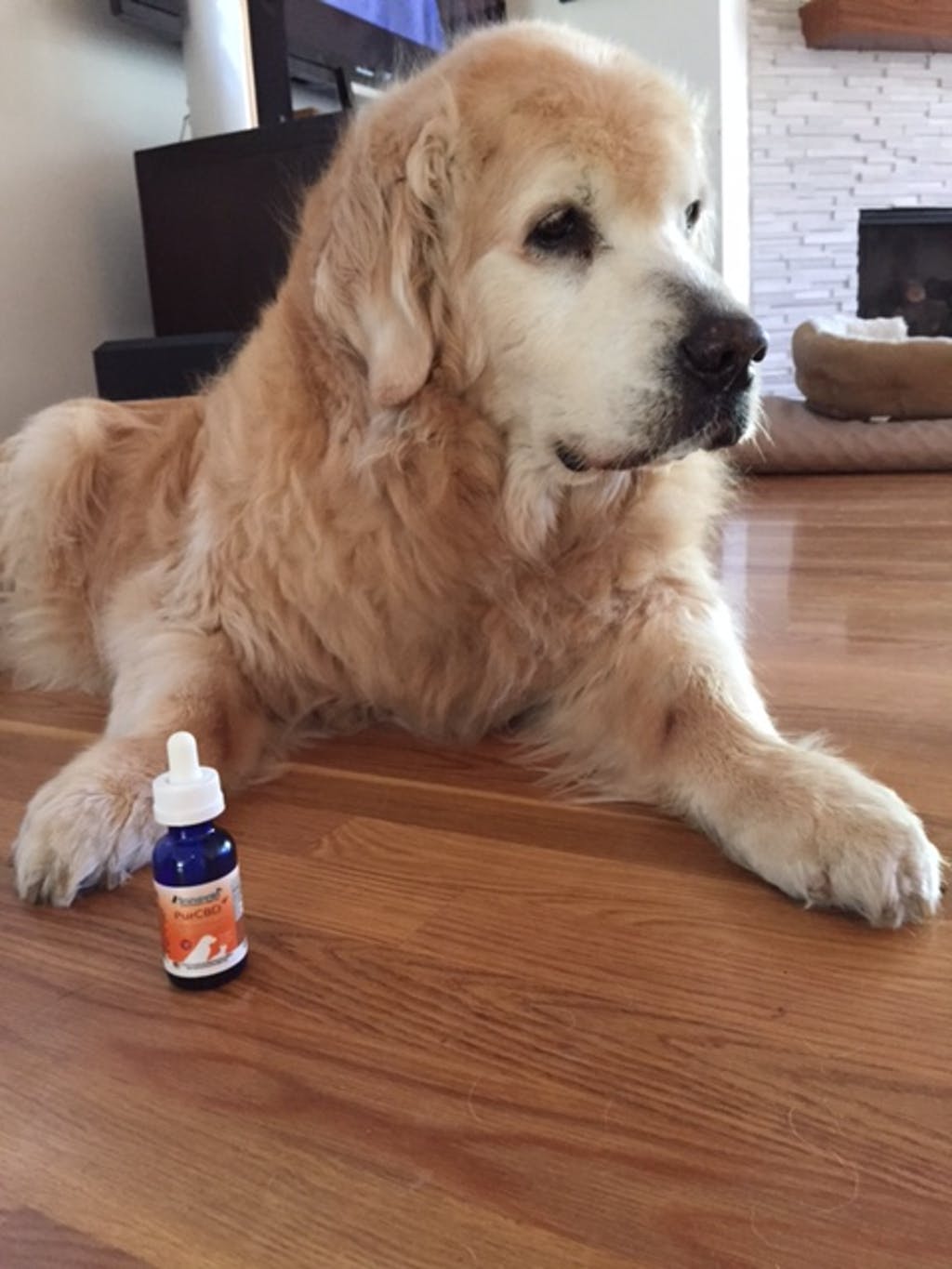Common Things We Do That Stress Our Dogs
Dec 01, 2018 01:37
If you found CBD’s recent explosion in popularity amongst people surprising, wait till you hear about how many are giving CBD to their dogs. The natural pet health industry is now saturated with CBD products and focus on it is quickly overtaking all other natural health supplements.
While it comes as a shock to many that cannabis use is so popular amongst humans, it’s even more so for dogs as they can overdose and die from large quantities of tetrahydrocannabinol (THC). All pet CBD is full spectrum which means it will contain small traces of THC — 0.3% or less. But clearly, this isn’t stopping people from giving CBD to their dogs and other pets. And one of the biggest reasons is CBD’s ability to reduce stress and anxiety.

Dogs are notorious for being anxious, and most dog owners can always find something that spells dread in their dogs: separation, loud noises, traveling, etc.. In fact, for many dogs, anxiety is the one medical issue they will deal with for most — if not all — of their life. Because of this, and the fact that anxiety in dogs doesn’t often solely warrant a vet visit, many dogs go untreated. But CBD looks to put an end to that.
This article is brought to you by Innovet Pet and their product line of cannabis for dogs.
The signs that your dog is stressed
If you’re a first-time dog owner, you’ll want to watch for all of these signs as they are classic indicators of stress and anxiety. And for seasoned dog owners, it’s always a great idea to go over signs from time to time since there are quite a few and it’s easy to chalk them up to normal behavior.
Avoidance
Sometimes we have a habit of giving human characteristics to our dogs, but this next one definitely isn’t one of those. When something causes us stress, instead of leaving the situation we ignore it. We’ll look away or get distracted with something frivolous — dogs do the same. They’ll excessively sniff the ground, lick themselves, and will be reluctant or completely avoid interaction.
Hinding
Your dog hiding or trying to escape a situation is more obvious than them avoiding something because it’s a progression of the symptom. Besides them running away and hiding behind or under something, they may try digging a hole or will nudge/pull you away from whatever is causing them stress.
Pacing and Shaking
Pacing around in circles or shaking are more serious signs compared to others on this list. Shaking can be a result of a disease or frigid temperatures so use other anxiety signs to confirm if anxiety is the issue. When it comes to pacing, make sure you don’t confuse this with them kneading an area or blanket before laying down to rest. Scientists believe this is an ancestral behavior as wolves mat down tall grass to create bedding areas.
Whining
Dogs bark and whine for lots of reasons — many dogs whine for attention as an example. But whining is definitely a sign your dog is anxious and afraid.
Eyes and ears change
Pulled back ears and big glassy doe eyes are synonymous with dogs. You’ll also want to look for rapid blinking and watch if they are holding a stare with you or something else.
Body Posture Changes
Another image synonymous with dogs is a tucked tail and lowered back end. Unless your dog has a hind leg issue, this almost always indicates they are afraid.
Licking, yawning, and drooling
When a dog is excessively licking their lips, it’s never a good thing — unless you gave them an indulgent treat that is. Excessive licking is often a sign that your dog is about to get sick. Most people will immediately think it’s because their dog ate something toxic, however, anxiety could be the culprit so be on the lookout.
Bathroom changes
This includes any change in their normal bathroom habits. From urination in the house, excessive urination to constipation.
Things We Do That Stress Our Dogs Out
Unfortunately, because many dogs are simply prone to anxiety, our everyday actions often exacerbate the issue. It’s important that all dog owners learn to check their behavior first before correcting their dog’s behavior. Let’s look at all the things we do to mess up our dogs.

Yelling at your dog for being a dog
Dogs do dog things like chewing, digging, sniffing things they shouldn’t sniff, and of course get into things they shouldn’t get in to. Strict training, when the dog is young, can help eliminate all of these issues, but unless your dog is a saint leaving that juicy steak unattended on the table is just asking for trouble. Instead of yelling redirect your dog to doing the right thing.
This is big when they are house training and have an accident in the house. Next time, don’t yell. Instead, give them a firm but quiet “no” then take them outside even if they did both number 1 and 2 in the house. Thank me later.
Not getting your dog space / always in their bubble
Kids are more guilty about this than adults, but sometimes even we can’t help ourselves and will smoosh our dogs to death. While no other animal loves humans like dogs, they need their space too. Watch pushing them back into corners or holding them even though they are pulling away. Sometimes a dog won’t pull away, and instead, their ears shoot straight back. Use the signs above to know when you’re loving your dog too much.
This is also important if you’ve recently adopted or rescued a puppy or dog.
Staring down a dog
Unless it’s your dog and you know they are cool with it, just don’t stare down a dog. It can scare them to where they will lash out with aggression. Most dogs don’t like locking attention with people or other animals regardless of the relationship.
Not sticking to your own rules
Dogs are incredibly smart, but their brains don’t work like us, and they don’t do well with irregularly placed rules. If you have a rule where you only reward treats for good behavior, don’t be sneaking them table scraps. Fortunately, you only need to stay super strict for the first year or two as they retain so much during this time. Old dogs can learn new tricks, it’s just harder because those first two years cement their behavior.
Poor exercise
Poor exercise equals boredom which leads to them misbehaving and us yelling. With saw this issue above when we learned to not blame a dog for being a dog. If your dog is digging or chewing, it could very well be a sign of boredom. Look at how terrible our behavior can be when we get bored. Plus, dogs don’t have TV or the Internet to distract themselves.
Changing up your verbal cues
Try to stick to the same word for the same behavior every time. Say you’re teaching your dog to hand you their paw, If you decided “shake” is the word, stick to it and stick to the same hand motion as well.
This is important in the beginning when they are taking in so much information. You‘ll have a lot of luck if you use a verbal command along with a motion as this helps reinforce the behavior. If your new puppy looks confused every time you say their name, the issue maybe you’re calling them by too many nicknames.
Telling your dog it’s OK when they are anxious
This is perhaps the most innocent one and the biggest one that causes anxiety. When your dog hears a loud noise and comes running to you, what do you do? If you answered “well, I tell them it’s OK with an empathetic tone” then you are giving your dog anxiety. It sucks, but it’s true.
This tone and our behavior 100% reinforces the dog’s reaction to the situation creating chronic anxiety to it. It’s normal for puppies to get scared at everything and we are so used to dogs freaking out about fireworks, us leaving the house, etc. that we overly coddle them. If it’s a harmless issue like fireworks, just ignore it because this shows them that there is nothing to worry about. Check your behavior first!
Types of Anxieties In Dogs
We break anxiety in dogs into two main forms based on the length and severity of the condition.
Situational or Temporary Anxiety
Situational anxiety is caused by things like loud noises, fireworks, thunderstorms, celebrations, etc. Your dog will only have a mild reaction to these issues when they occur, and the severity will not warrant prescription medication.
Behavioral or Chronic Anxiety
You can tell if your dog has a behavioral and chronic anxiety condition if you’re coming home to a house that looks like a hurricane hit it. You will probably notice accidents in the house even though the dog is housebroken You’ll notice that your dog is always on edge, they anticipate loud noises, you leaving, etc. and this makes mountains of molehills creating harmless triggers.
CBD For Stress and Anxiety
There are countless reports of people loving CBD for managing their anxiety conditions. Studies backup that CBD can pretty much tackle anxiety regardless of the source. In fact, this is one area where CBD beats out THC and marijuana for better relief of a medical condition. It only losing to THC when it comes to PTSD-related anxiety conditions.
CBD offers an effective over-the-counter anxiety medication which is something that’s glaring missing in both the human and pet health world. Because humans and dogs share an endocannabinoid system and serotonin 5-HT1A receptors, we both react equally to CBD ability to reduce anxiety.
For those that have not used CBD for themselves, CBD effects are best described as tangible and similar to an over-the-counter medication. CBD acts on receptors that modulate perception to anxiety and will regulate this defensive behavior. This in no way dampens emotional response. And while CBD acts on the same receptors that common anti-anxiety and antidepressants — known as SSRIs — CBD does not bind to them in the same way and thus avoids the side effects associated with them.
Along with CBD’s ability to reduce inflammation and help manage epilepsy, anxiety is as one of the top reasons people give their dogs CBD.
More Stories:
http://fooyoh.com/iamchiq_living_lifestyle/8686042/your-pet-is-obese-because-it-is-sick-of-your-shit







































































